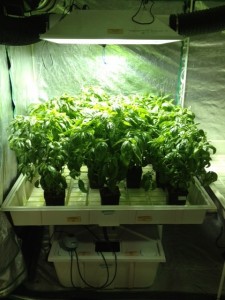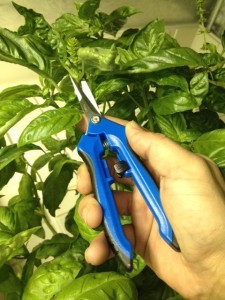An enormous amount of growth has occurred since my last update on the hydroponic sweet basil. As full as the tray is getting, it’s safe to say that our project nears its conclusion! As is evident in this photograph, our objective- hydroponically growing basil from seed- was a success.

I plan to ‘top’ the plants one more time to remove any flowers or buds that have begun to form as the basil bolts (i.e. the transition from the vegetative, to the generative or reproductive phase which we don’t want). I really like our Precision Pruning shears for this task. They are lightweight and have a locking mechanism and holster for safe storage when not in use. Of course, my favorite feature is the spring mechanism; for high volume trimming like will be required to harvest this basil, you’ll be thankful for the resetting action of the spring.

Expect another update soon!
Until next time,
Urban Farmer Brandon (still tweaking the nickname)
P.S. I recently engaged in a discussion with a colleague about how difficult it can be to separate genuine product reviews from manufacturer sponsored ones. The good readers of this blog should know that neither I, nor Fifth Season Gardening Co. is paid or compensated by other companies in any way for featuring products in this blog. Rather, they are items that we think are worth the cost and will deliver results, period. And that won’t change. Thanks for reading!

kailgreene says
spp.) as the aquatic species. Non-circulating floating raft systems were designed using 95 L polyethylene tanks. Equal amounts of start-up fertilizer dose were applied to both systems. The objective was to understand how the additional nutritional dynamics associated with crayfish influence the basil crop. Both fresh and dry basil plant weights were collected after harvest, followed by leaf nutrient analysis. Leaf chlorophyll content, water pH, nitrogen and temperature were measured periodically. Aquaponic basil (AqB) showed 14%, 56%, and 65% more height, fresh weight, and dry weight, respectively, compared to hydroponic basil (HyB). It is logical to assume that crayfish waste (excreta and unconsumed feed) has supplied the additional nutrients to AqB, resulting in greater growth and yield. The chlorophyll content (plant quality) or leaf nutrients, however, did not differ between AqB and HyB. Further research is needed to investigate aquaponic crayfish yield, overall nutritional dynamics, cost-benefit ratio, and other plant characteristics under soilless systems.